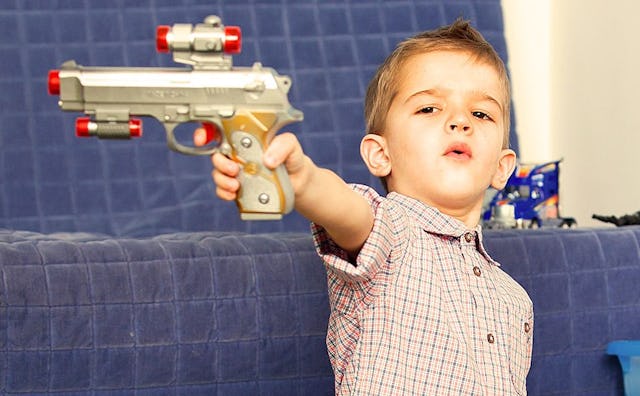Why Kids Playing With Pretend Guns Is Just Fine

My 5-year-old son is in a gun phase, and I haven’t known how to handle it. His little friends’ parents have also expressed bafflement at our normally sweet, peaceful boys pretending to be vigilantes, shooting one another from around corners, skidding down the hallway with bananas brandished like revolvers. It’s like living in a Die Hard movie, preschool version. From the kitchen, listening to the mayhem, we cringe, but exactly what to do about it is unclear: On the one hand, hearing a small child plead for his life in a scene reenacted from Frozen is…unnerving. On the other hand, generations of children have played with pretend guns—it seems like a normal part of childhood. And no matter what, regulating pretend play is just plain difficult: My son plays with water guns in the summer, and last winter when I stopped him from pretending to shoot his brother, he said “I’m pretending to squirt him.” Okay, touché. In short, I haven’t settled on a coherent way of dealing with violent pretend play. The only firm rule we have is that if another kid is scared by any pretend play, it has to stop. But still, I’ve been uneasy. Am I implicitly endorsing violence by not putting a stop to it?
Today I came across an article by science writer Melinda Wenner Moyer: “It’s Fine for Kids to Play With Pretend Guns,” which summarizes the recent research on kids and violent pretend play. In short, pretend gunplay is normal and even developmentally appropriate, helping kids learn to control their more aggressive impulses. She reports:
“In a 2013 study, researchers observed how preschoolers played by themselves with various objects and then watched these same children in their classrooms. They found that the more oral aggression the kids displayed—for example, pretending that stuffed animals bit or ate each other—the less aggressive their behavior was in the classroom. The researchers speculate that when kids incorporate violence into their pretend play, they may learn how to control real violent impulses and regulate their emotions.”
She does offer the caveat that some children are just, well, aggressive, and if a kid is actually hurting other kids while they’re playing, that’s cause for concern. As is mindless, unimaginative violence, like repeatedly bashing a doll’s head over and over with no accompanying narrative.
As for putting a stop to pretend gunplay, psychologists have even warned that preventing kids from acting out these impulses might even be harmful. Wenner Moyer writes:
“Another recent paper penned by academic psychologists went so far as to argue that preventing kids from play fighting could interfere with their social, emotional, physical, cognitive, and communicative development. Although we can’t be certain that this relationship is causal—it’s possible that kids who are more socially mature simply tend to play more aggressively—one thing is clear: ‘Aggressive behavior in pretend play is different than actual aggressive behavior in real life,’ says co-author and Case Western Reserve University child psychologist Sandra Russ.”
So I can relax a little about all this pretend gunplay, and focus on the real problem—real guns. As Moyer points out, guns are the second-leading cause of death for children, ages 1 to 19, in the United States. Parents don’t need to worry about pretend guns. We need to worry about real ones.
This article was originally published on